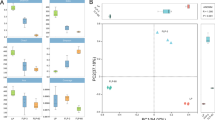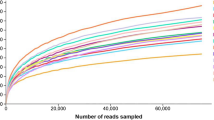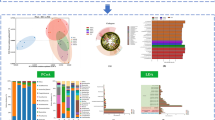Abstract
For a more eco-friendly production of energy and chemicals (e.g. lactic acid), green biorefineries are implementing an environmentally conscious technique of using green biomass. To increase the amount of lactic acid in grass and rye silage, different ensiling treatments were conducted. Additionally, after separating the organic juice, the specific methane yield of the remaining solid residue of the ensiled material was determined. The amount of lactic acid was increased by 168.8 % (149.7 ± 20.9 g kg−1 dry matter (DM)) through applying homofermentative lactic acid bacteria together with carbonated lime to the raw material grass. For rye, while having a stable silage, the highest increase in lactic acid was achieved by chopping the raw material to a theoretical length of cut of 1 mm. As a result, an increase of 46.3 % (57.5 ± 0.6 g kg−1 DM) was attained. Taxonomic profiling by 16S amplicon sequencing revealed that the homofermentative species Lactobacillus plantarum was the most dominant species on both substrates with highest lactic acid production rate, though its growth on rye led to unstable silage conditions with butyric acid producing Clostridia. The specific methane yields of the corresponding solid residues were determined to be 335.7 ± 7.2 lN kg−1 organic dry matter (ODM) for grass and at 235.0 ± 2.6 lN kg−1 ODM for rye.





Similar content being viewed by others
References
Kamm B, Kamm M (2004) Principles of biorefineries. Appl Microbiol Biotechnol 64:137–145
Kamm B (2007) Production of platform chemicals and synthesis gas from biomass. Angew Chem - Int Ed 46:5056–5058
Kromus S, Wachter B, Koschuh W, Mandl M, Krotscheck C, Narodoslawsky M (2004) The Green Biorefinery Austria—Development of an integrated system for green biomass utilization. Chem Biochem Eng Q 18:7–12
Cherubini F, Jungmeier G, Wellisch M, Willke T, Skiadas I, van Ree R, de Jong E (2009) Toward a common classification approach for biorefinery systems, Biofuels. Bioproducts Biorefining 3:534–546
Weinberg ZG, Muck RE (1996) New trends and opportunities in the development and use of inoculants for silage. FEMS Microbiol Rev 19:53–68
Kandler O (1983) Carbohydrate metabolism in lactic acid bacteria, Antonie van Leeuwenhoek. Int J Gene Mole Microbiol 49:209–224
McDonald P, Henderson N, Heron S (1991) The Biochemistry of Silage. Marlow, Bucks
Bolsen KK, Ashbell G, Weinberg ZG (1996) Silage fermentation and silage additives—Review. Asian-Australasian J Animal Sci 9:483–493
Pitt RE, Muck RE, Leibensperger RY (1985) A quantitative model of the ensilage process in lactate silages. Grass Forage Sci 40:279–303
Lindgren S, Pettersson K, Kaspersson A, Jonsson A, Lingvall P (1985) Microbial dynamics during aerobic deterioration of silages. J Sci Food Agric 36:765–774
Herrmann C, Heiermann M, Idler C (2011) Effects of ensiling, silage additives and storage period on methane formation of biogas crops. Bioresour Technol 102:5153–5161
Henderson N (1993) Silage additives. Anim Feed Sci Technol 45:35–56
Herrmann C, Heiermann M, Idler C, Prochnow A (2012) Particle size reduction during harvesting of crop feedstock for biogas production i: effects on ensiling process and methane yields. Bioenergy Res 5:926–936
Haag NL, Nägele H-J, Fritz T, Oechsner H (2015) Effects of ensiling treatments on lactic acid production and supplementary methane formation of maize and amaranth—an advanced green biorefining approach. Bioresour Technol 178:217–225
Mayne CS (1990) An evaluation of an inoculant of Lactobacillus plantarum as an additive for grass silage for dairy cattle. Anim Sci 51:1–13
German Agricultural Society, DLG (2000) DLG guideline for the testing of silage additives on DLG quality mark capability. DLG Verlag, Frankfurt am Main
Huenting K, Aymanns T, Pries M (2012) Fermentation potential of corn silage, XVI International Silage Conference 356–357
German Institute for Standardization (2001) DIN., DIN EN 12880: Characterization of sludges—determination of dry residue and water content; German version EN 12880:2000
German Institute for Standardization (2001) DIN., DIN EN 12879: Characterization of sludges—determination of the loss on ignition of dry mass; German version EN 12879:2000
Weissbach F, Strubelt C (2008) The correction of the dry matter content of grass silage as a substrate for biogas plants. Landtechnik 63:210–211
Weissbach F (1998) On the methodology of determining the fermentation losses in silage, Jahresbericht der FAL. 26–26
E. Commission Regulation (2009) Commission Regulation 2009/152/EC Laying down the methods of sampling and analysis for the official control of feed, Official Journal of the European Union. L 54/1
Federation of German Agricultural Investigation and Research Institutes, VDLUFA (2007) Method Book III—the chemical analysis for feedstuffs. VDLUFA Verlag, Darmstadt
Klindworth A, Pruesse E, Schweer T, Peplies J, Quast C, Horn M, Glöckner F O (2013) Evaluation of general 16S ribosomal RNA gene PCR primers for classical and next-generation sequencing-based diversity studies. Nucleic Acids Res. 41
Wood D E, Salzberg S L (2014) Kraken: ultrafast metagenomic sequence classification using exact alignments. Genome Biol. 15
Helffrich D, Morar M, Lemmer A, Oechsner H, Steingaß H (2005) Laboratory method for determining the quality and quantity of biogas produced from anaerobic decomposition of organic substances in a batch process
VDI-Society Energy and Environment, VDI (2006) VDI 4630: Fermentation of organic materials—characterization of the substrate, sampling, collection of material data, fermentation tests
Gerighausen H (2011) Praxishandbuch Futter- und Substratkonservierung. DLG Verlag, Frankfurt am Main
Bayerische Landesanstalt für Landwirtschaft, LFL (2015) Gruber Tabelle zur Fütterung der Milchkühe, Zuchtrinder, Schafe und Ziegen, LfL-Information. 37:1–94
Weinberg ZG, Ashbell G, Azrieli A, Brukental I (1993) Ensiling peas, ryegrass and wheat with additives of lactic acid bacteria (LAB) and cell wall degrading enzymes. Grass Forage Sci 48:70–78
Pahlow G, Muck RE, Driehuis F, Oude Elferink SJWH, Spoelstra SF (2003) Microbiology of ensiling. In: Al-Almoodi L, Barbarick KA, Volenec JJ, Dick WA (eds) Silage Science and Technology, American Society of Agronomy, Inc.; Crop Science Society of America, Inc. Soil Science Society of America, Inc., Madison, pp 31–93
Salter SJ, Cox MJ, Turek EM, Calus ST, Cookson WO, Moffatt MF, Turner P, Parkhill J, Loman N J, Walker AW (2014) Reagent and laboratory contamination can critically impact sequence-based microbiome analyses. BMC Biol 12
Pritchard GG, Coolbear T (1993) The physiology and biochemistry of the proteolytic system in lactic acid bacteria. FEMS Microbiol Rev 12:179–206
Dabrock B, Bahl H, Gottschalk G (1992) Parameters affecting solvent production by Clostridium pasteurianum. Appl Environ Microbiol 58:1233–1239
Prochnow A, Heiermann M, Plöchl M, Linke B, Idler C, Amon T, Hobbs PJ (2009) Bioenergy from permanent grassland—a review: 1. Biogas. Bioresour Technol 100:4931–4944
Amon T, Amon B, Kryvoruchko V, Machmüller A, Hopfner-Sixt K, Bodiroza V, Hrbek R, Friedel J, Pötsch E, Wagentristl H, Schreiner M, Zollitsch W (2007) Methane production through anaerobic digestion of various energy crops grown in sustainable crop rotations. Bioresour Technol 98:3204–3212
Kromus S, Novalin S, Koschuh W, Hong Thang V, Krotscheck C (2003) Green biorefinery—separation of lactic acid from grass silage juice
Acknowledgments
The authors are grateful to Annette Buschmann (University of Hohenheim, State Institute for Agricultural Engineering and Bioenergy, Germany) for analysing numerous samples and her dedicated work in the laboratory. Furthermore, the authors thank Dietmar Ramhold and Thomas Fritz (ISF GmbH, Germany) for providing the silage additives. Finally, the authors thank Philip Stevens (Fraunhofer Institute for Interfacial Engineering and Biotechnology IGB, Germany) for his support and helpful comments on Kraken.
Funding
This work was funded by the Federal Ministry of Education and Research (BMBF) within the scope of the project “GOBi - General Optimization of Biogas Processes; FKZ 03EK3525A.”
Conflict of interest
The authors declare that they have no conflict of interest.
Author information
Authors and Affiliations
Corresponding author
Electronic supplementary material
Below is the link to the electronic supplementary material.
ESM 1
(XLSX 18 kb)
Rights and permissions
About this article
Cite this article
Haag, N.L., Grumaz, C., Wiese, F. et al. Advanced green biorefining: effects of ensiling treatments on lactic acid production, microbial activity and supplementary methane formation of grass and rye. Biomass Conv. Bioref. 6, 197–208 (2016). https://doi.org/10.1007/s13399-015-0178-2
Received:
Revised:
Accepted:
Published:
Issue Date:
DOI: https://doi.org/10.1007/s13399-015-0178-2




